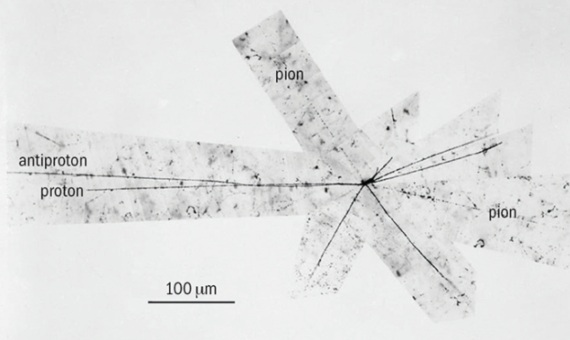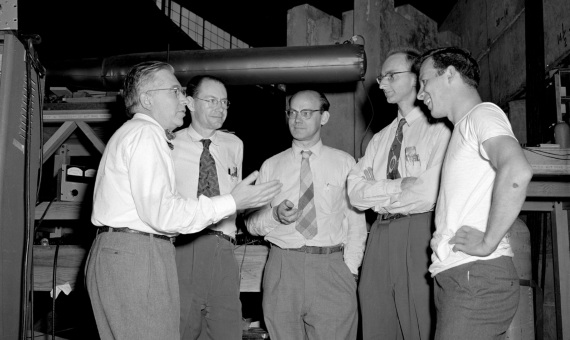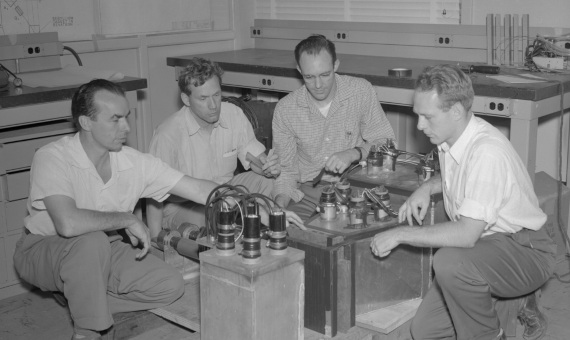Just when the structure of matter seemed clear, another great achievement ushered in a new era in physics. The discovery of the antiproton in 1955 confirmed the existence of antimatter and opened the door to the study of the great questions about the origin of the universe and the Big Bang, which still remain unresolved today. But it also opened up a wound between two great scientists and led to a lawsuit to clarify the discovery, something unprecedented in the history of particle physics.
In 1954, with the inauguration in Berkeley (California, USA) of the Bevatron —the largest particle accelerator built until then— physics now had the definitive tool to undertake the search for the antiproton. It had been one of the great remaining challenges of physics since 1932 when Carl David Anderson discovered the positron, which was like an electron but with a positive charge. His had been the first antiparticle ever detected, after Paul Dirac had predicted their existence in 1928 by combining relativity with the quantum view of the atom. Once the antiparticle of the electron had been found, all that remained was to find that of the proton to confirm the theory.

Two teams with the best physicists
The Radiation Laboratory at Berkeley designated two independent teams —composed of some of its best physicists— to undertake the task, each with different approaches in order to double the chances of success. One of them was led by the Italian Emilio Segrè (February 1, 1905 – April 22, 1989), who was already a scientific authority at the time, having used a particle accelerator in 1937 to discover technetium, the first artificially synthesized chemical element. Segrè was Jewish and had to flee from the fascist regime established by Mussolini in Italy. In 1940, then working at Berkeley, and having the use of a cyclotron, he managed to isolate astatine, the scarcest natural element on Earth, for the first time. Both of these achievements led him to be recruited for the Manhattan project where he made important contributions towards helping the United States create the atomic bomb.
Years after the end of the Second World War, Segrè ended up returning to Berkeley, where he embarked on the race to find the anti-proton. The objective of the competing teams was to devise an experiment to detect this antiparticle, so ephemeral, in the very short time (about 10-7 seconds) between its presumed formation and its annihilation on contact with ordinary matter. Segrè and his team decided that the best option to confirm its existence was to measure two independent properties: momentum and speed. But how to do this? With what apparatus and devices?

Just then, at the end of 1954, the brilliant Italian physicist Oreste Piccioni (October 24, 1915 – April 13, 2002) arrived at the Berkeley Radiation Laboratory with an idea to measure the instant of the antiproton —through powerful focusing lenses of a novel design— which excited Segrè’s group. Unfortunately for Piccioni, his request for a longer stay in the laboratory was rejected. Segrè’s group decided that they could not afford to wait for him and continued working, now following the line suggested by Piccioni. When Piccioni finally received permission to return to Berkeley in late summer 1955, the definitive experiment had been concretized (with lenses equivalent to those he had suggested) and Segrè did not accept his request to join the team. A disappointed Piccioni ended up working on the rival team.
The first evidence of antimatter
Both teams took scrupulous turns in running their experiments on the Bevatron, until on September 21, the other team (led by Edward Lofgren) gave up their turn on the particle accelerator and handed it over to the team that Emilio Segrè was leading with Owen Chamberlain. As fate would have it, it was during that turn when the first evidence of the existence of the antiproton was obtained. After two weeks of intense testing, on October 19, 1955 they announced the discovery at a press conference, which was later detailed in an article published in the journal Physical Review. Months later, Piccioni participated (along with some members of Lofgren’s group) in the discovery of the antineutron, which further supported the existence of antimatter.

However, in 1959 the Nobel Prize in Physics recognized only Chamberlain and Segrè, forgetting the discoverers of the antineutron. Nevertheless, the two laureates did remember Piccioni, and during the award ceremony they expressed their gratitude for his important contributions to the antiproton experiment. However, this mention did not manage to bridge the gap between the two Italian physicists. Years later, in 1972, when everything seemed to be water under the bridge, Piccioni filed a lawsuit demanding compensation in the amount of $125,000 for damages suffered by him and seeking public acknowledgment by Segrè and Chamberlain that the design of the experiment had been his. The lawsuit was ultimately unsuccessful, even though it reached the US Supreme Court, and Piccioni failed to become Segrè’s “anti-Nobel”. Official recognition for his outstanding contributions to particle physics came in 1998, when the Italian National Academy of Science awarded Oreste Piccioni the Matteucci Medal, previously awarded to such important scientists and inventors as Lord Kelvin, Edison, Marconi, the Curies, Einstein, Rutherford, Fermi, Heisenberg, Schrödinger and Freeman Dyson… but not Emilio Segrè.
Comments on this publication